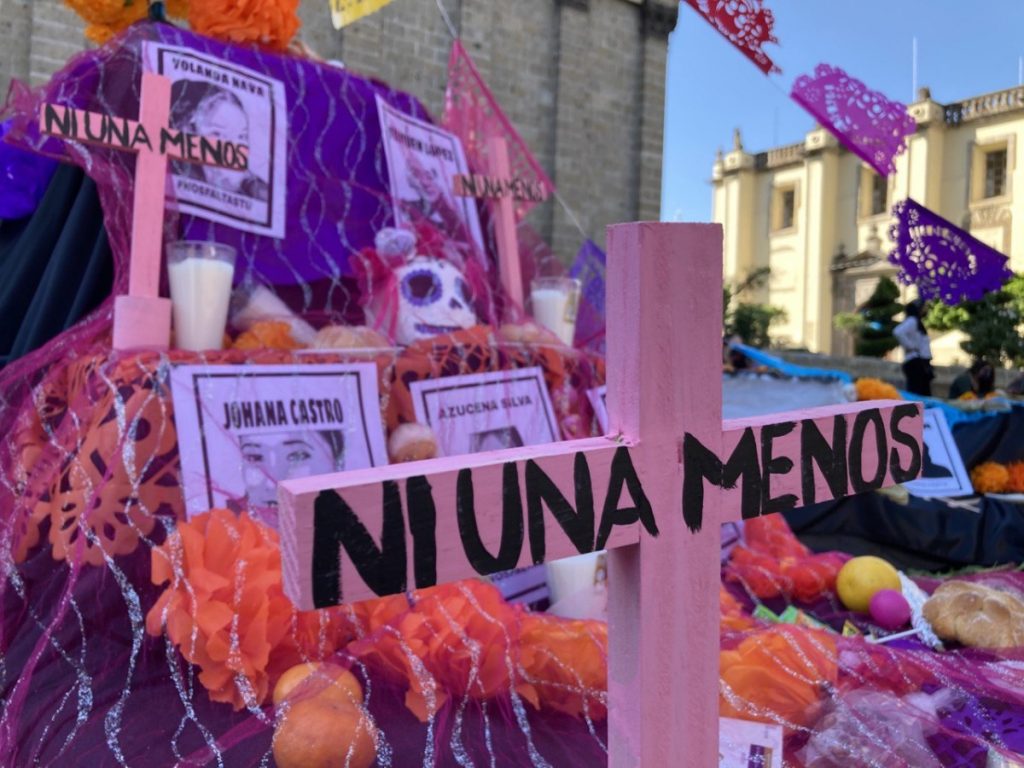On March 8, the feminist movement flooded the streets of Mexico as part of a global day of mobilization. Among these thousands of women and dissidents, the main demand was an end to femicide and sexist violence.
In Mexico, femicide is a phenomenon that notoriously spread in the 1990s. Ciudad Juárez, one of the largest working-class cities in the country, thanks to rapid industrialization under the Free Trade Agreement (NAFTA), constantly appeared in the international press owing to the high level of women murdered within its city limits.
The relocation of production during the neoliberal period allowed for the rise of Ciudad Juárez as an industrial zone because of its abundant migrant labor and its advantageous location on the border for the transfer of goods. This proved lucrative for imperialism and the bourgeoisie on both sides of the Río Bravo, given how close it is to El Paso, Texas. In this context, femicide and trafficking networks spread.
While the mothers of victims, activists, women, and human rights organizations continue to fight for justice and denounce the violence, the authorities have announced various policies supposedly aimed at curtailing this brutal scourge, which hits working women with special viciousness. Far from solving the problem, their “solutions” have instead confirmed the state’s complicity and apathy.
Femicide has increased in recent years, as a result of Mexico’s militarization went through during the “war on drugs,” which started in 2006 under the administration of President Felipe Calderón. Juárez became a laboratory city, its policies spreading throughout the country and bringing with it deadly violence against women. In 2015, under the government of President Enrique Peña Nieto — almost a decade after the extensive militarization began — there were seven femicides a day in all of Mexico. Today, under the “progressive” government of President Andrés Manuel López Obrador and his Fourth Transformation (4T) government, the number has risen to 11 a day. These statistics should, however, be taken with a grain of salt, since these include only cases categorized as femicide, which represent barely a third of intentional homicides against women, according to official figures from the National Public Security System.
What Is Femicide?
Femicide is the last link in a long chain of violence against women, which disproportionately affects poor and working women. Women who live in the peripheries and who use public transportation are more exposed to structural violence. Hand in hand with the country’s militarization, femicide has increased and spread throughout the republic, at the same time strengthening trafficking and prostitution networks.
Femicide has a disciplining effect, sending a clear message about the risks and consequences of transgressing the patriarchal system: in Mexico, it seems, if you murder a woman, “no pasa nada” (nothing happens).
According to the Mexican Federal Criminal Code, Article 325, Chapter V, femicide is defined as a crime against a woman’s life and bodily integrity. This was established in 2012 after the Campo Algodonero case, in which a court ruled that “the crime of femicide is committed by anyone who deprives a woman of her life for reasons of gender.”
This generic definition leaves out much, and in recent years the definition of femicide has been widely debated and defined in feminist circles. Some groups concentrate on the viciousness and violence against women in these murders, focusing on the need to define the crime in order to increase punishments and penalties. Others aim to hold the state and institutions responsible for their “malfunctioning” in order to propose policies that seek to improve the administration and management of bourgeois justice, which also implies the demand for more punitive policies.
Finally, there’s a third group that problematizes the social origin of violence, proposing different ways to confront it, among them socialist feminists. This grouping within the feminist movement in Mexico believes that male violence is in the veins of the capitalist state and cannot be eradicated without sweeping away the state and its institutions, transforming current society and building a new, revolutionary society without oppression and exploitation.
Debating the Concept
The word femicide first appeared in Feminicide: The Politics of Woman Killing (1988), a volume edited by Jill Radford and Diana E. H. Russell. Radford stated that femicide is “misogynistic murder of women committed by men; it is a form of sexual violence.”
Later, in the same work, Russell and Jane Caputi specified,
Femicide is the extreme end of a continuum of anti-female terror that includes a myriad of forms of verbal and physical abuse, such as rape, torture, enslavement, incest and extrafamilial child sexual abuse, physical and emotional abuse, harassment, genital mutilation, unnecessary gynecological operations, forced heterosexuality, forced sterilization, forced motherhood, psychosurgery, denial of food to women in some cultures, cosmetic surgery, and other mutilations in the name of beauty. As long as these forms of terrorism result in death they are femicides.[2]
Gender violence is expressed in diverse ways, contributing to the disciplining of women by sending messages through the bodies of the murdered. Women are often left dead on public roads, naked, words sometimes written on them, their bodies mutilated, with various other horrific cruelties that are then presented in public spaces for the world to see.
These specific aspects of violence on the body are highlighted by both Marcela Lagarde’s and Rita Segato’s definitions of femicide, both of which point to the state’s responsibility. They become problematic, however, when they liquidate the class character of the capitalist state. According to them, if the state were functioning correctly by guaranteeing the rule of law, the capitalist state could safeguard the women’s safety by playing the role of guardian, or “mother state,” in Segato’s words.
The capitalist state is not neutral, choosing to protect private property and the interests of the capitalists. The “institutional collapse,” or “failure of the rule of law,” which leads to a “failed state,” in Lagarde’s logic, hides the fact that violence against women also has a class character. Patriarchal oppression in capitalism is reconfigured in the service of capitalist exploitation.
The fact of the matter is, oppression in its essence serves the material conditions in which it develops. It is the capitalist class that materially sustains oppression, and being working class, poor or displaced delineates a very different contour of how one experiences violence. This, of course, does not detract from the fact that there are cases of violence among affluent and dominant sectors of the female population. But the material conditions in the productive structure of capitalist society, the level of education, income, etc., have an impact on how violence is experienced, particularly violence against women.
These conceptions are rooted in the bourgeois liberal theory of the state and in a punitive society that seeks to provide carceral solutions to this violence, including the increasing reliance on prisons based around the demands of carceral feminists. But there is another side to this discussion.
For example, Lagarde and Mariana Berlanga define femicide as a “state crime” resulting from the state’s responsibility for the lack of public safety policies. This definition equates femicide with all state crimes, such as those committed by repressive forces, whether the army or the police.
The capitalist state is, indeed, responsible for the policies of precariousness, violence, and attacks on the living conditions of women and the great laboring majorities. But, by labeling all femicide as a state crime, we run the risk of leaving in the shadows the complexities and different expressions that this terrible and reactionary phenomenon has developed. Particularly that of violence orchestrated by “peers” — coworkers, family members, partners, or acquaintances who embody the most rotten aspects of machismo and misogyny.
On the other hand, we cannot forget the seriousness of these crimes against humanity and the Mexican state’s systematic involvement and active participation of these repressive bodies. Mexico has a long history of such actions, as we saw with Ayotzinapa. Additionally, it has a history of consciously responding, in a counterrevolutionary manner, to the rise of class struggle and the upswing of revolution. Examples of such actions are the military dictatorships in the Southern Cone during the 1970s and the genocide against an entire generation of workers and young activists. Public policy in Mexico has also been violently used without weaponry, for example, the forced sterilizations of Mayan indigenous women and of persecuted peoples during the dirty war in Guatemala, whose objective was ethnic extinction.
In these cases, when it comes to crimes against humanity and against women, it would be more appropriate to speak of “femigenocide,” as proposed by Segato. This distinguishes the specificities of each case in order to reinforce the denunciation of the capitalist state and the expressions of machismo, which translate into femicide.
The framework we are working from is that the Mexican state functions through oppressive power relations in a social formation marked by imperialist subordination and a dependent, semicolonial capitalism with strong features of social decomposition. As a consequence of all this, the macho culture in Mexico, rooted in popular culture, in songs, popular sayings, and common values, has created the phenomenon of femicide as a two-sided coin. The aggressors responsible may occupy a higher place in the political and social hierarchy, such as businessmen, members of the military, or members of the political elite. The other side of the coin is when the perpetrators of violence are seen as “peers,” or community members. This is what Segato would call the “horizontal axis” of violence.
Capitalism and Patriarchy, Two Faces of Bourgeois Domination
Machismo, as a practical expression of ruling-class ideology, has controlling women as its primary objective. But, in the case of the working class and popular sectors, this means the division is based on class lines: the competition between female and male workers. This competition is used by the employers to diminish the value of the labor force, since patriarchy and machismo justify women and girls’ being paid less for the same work. This is a great technique to put downward pressure on wages as a whole, because if any male worker refuses to work for low wages, he faces competition from the enormous reserve army of women. It works in the same way with migrant labor in the United States, based around the discrimination generated by racism. In this way, the lives of the working class as a whole are devalued.
At the same time, the patriarchal pact demands that women be subordinated to me and must be disciplined at all costs. One way this plays out is through convincing a small number of women to replicate this patriarchal hierarchy by integrating them with high-powered positions with male privileges. For example, women in powerful managerial positions or with a high level of income that contrasts with the conditions of the vast majority of women. The other way is with methods of force, such as physical violence, including femicide.
The debate on violence cannot be kept in the private sphere, a term which refers to the punishment and the judicialization of bourgeois criminal law. This structure has limitations, which will never put the patriarchy on trial or the institutions responsible for structural violence. Even if femicide is a result of “interpersonal relationships” or “the aggressor’s personality,” femicide must be considered a social phenomenon with multiple concrete expressions. We must link it to the structural framework, which is based on the cultural and sociopolitical development of the time.
For example, we cannot ignore the debates on the vulnerability of working-class women, put in a place of precariousness and loss of purchasing power during this volatile time of inflation. Also, we must examine the disruption of the “mandate” that the capitalist and patriarchal system imposes on men with their position as “providers” in their family, which always implies the ownership men (fathers, brothers, husbands, etc.) have over women’s bodies and lives as part of the justification of the current social order. This system commodifies and exploits bodies as a labor force and reads these bodies as disposable.
The situation of violence has deepened in Mexico. In the heat of rapid expansion of the military and organized crime, the situation of poverty and inequality has deepened. The inaccessibility of opportunities and an ability to exercise rights has created a perfect breeding ground to reinforce a sexist and misogynist culture. The reactionary alliance between the state and the churches in recent decades encourages this breeding group, supported by the anti-rights agenda of conservative sectors and parties such as the National Action Party (Acción Nacional).
In the face of femicidal violence, which increasingly presents itself as violence among “peers” or in the “private” environments of the victims’ lives (family members, partners, neighbors, etc.), the discussion must focus on how to combat machismo and build less oppressive, more liberating relationships, with greater companionship and camaraderie. We must build networks with those who share a deep and conscious conviction to confront those who benefit from this violence and use it to maintain this system of exploitation, protecting their multimillion-dollar profits: the businessmen and the ruling class.
The fight against machismo must be fought among the ranks of the working class. This struggle must be taken up alongside with the force of trade union organizations. The demand for the struggle against violence and femicide is fundamental. This struggle is not, however, seen as a central demand among all leftist groups in Mexico. Most of the populist and pro-Stalinist Left — including the guerrilla tradition in Mexico — do not agitate against femicide, an unfortunate and fatal omission.
The responsibility of the Mexican state in perpetuating the structural conditions for violence against women is evident. While denouncing the precariousness of labor, the state continues its program of militarization and the so-called war on drugs. These policies have support across bourgeois party lines; all the major parties, including the National Action Party, the Institutional Revolutionary Party, and the Democratic Revolutionary Party, support building the military apparatus. The Morena government has only maintained and increased these policies.
We must continue pointing out how the structure of the bourgeois government is the basis of women’s vulnerability to violence. Working women or women from lower-income sectors are the most exposed to this violence. We must denounce the army and repressive bodies, linking this to the demand for demilitarizing the country. We must urgently push for and develop a powerful feminist movement in the streets in order to confront violence and precariousness with the mobilization and organized strength of the working class. Doing so is a key and crucial weapon in fighting femicides.
In addition, we must critically address the state institutions’ responses to these murders. Often, the state attempts to hide femicides by labeling them “crimes of passion” or other categories. And it sets up obstacles to solving and resolving these cases, especially when state agents are involved. This sends a message that “women’s lives do not matter.” In Mexico, 95 percent of femicide cases remain unsolved.
That is why it is fundamental to fight for investigations independent of the state, made up of specialists, feminists, activists, human rights organizations, unions, and families. We demand that the state give total access to all necessary evidence and investigative material to this independent investigative team and allow for total control of the course of the investigation. This is a key demand to avoid the obstruction of evidence and the fabrication of truths to protect officials and businessmen involved or to produce scapegoats.
Since oppression and exploitation are deeply articulated in the capitalist order, femicide has played a crucial role in sustaining bourgeois class domination historically and internationally. This debate is developed by Silvia Federici in her book, Caliban and the Witch, in which she argues that femicide, as a social and historical phenomenon, has had multiple dimensions in its deployment as a mechanism of social control of the female collective to preserve and guarantee the patriarchal mandate. This mandate constrains women to the domestic and private sphere, to spend their time on reproductive tasks and, fundamentally, as a disciplining mechanism against resistance to the advance of capitalist production relations in the artisanal economy of medieval Europe.
The key to a Marxist understanding of this topic is that oppression is used as a mechanism to deepen exploitation. That is, it expresses the configuration of the labor force’s commodification. Poor and working women in regions where femicide happens most often (peripheral, working-class, and migrant cities) are consumable and disposable commodities. In addition, femicide serves as a mechanism of the social discipline that the ruling classes impose on women. The victims are mostly poor and working women, but they also include women from other classes; this ensures complacency and inaction against patriarchal policies, such as war, precariousness, and capitalist exploitation, securing ruling-class hegemony.
As a mechanism, femicide generates profits for the ruling classes or the illegal bourgeoisie through the commodification of women’s bodies — in addition to being part of the network of goods trafficked by organized crime beyond drugs. This implies recognizing, in contrast to what Segato argues, that even in those cases in which women’s bodies are involved, there is no doubt that women’s bodies are the victims of organized crime. Even in those cases in which criminal corporations are involved, the result ends up contributing to the hegemony of the dominant classes, through the disciplining and imposition of terror, which often strengthens the punitive positions of guardianship and intervention of the state to “preserve” the security and integrity of the population.
We Want All Our Rights, but We Also Want to Put an End to Capitalism
All the above entails the need to raise a policy of denouncing the state, its institutions, and the government. To obtain all the favorable material conditions that would benefit our class, and to free women from domestic slavery, we must demand better living conditions — street lighting, dignified and free transportation 24 hours a day, laundries, public kitchens, and subsidized day care centers.
Our perspective, which differs from that of sectors that focus on punitive action, seeks to fight for the implementation of all possible measures and resources to prevent femicide, attacking all the conditions of structural vulnerability that women face. The fight for better working conditions, better infrastructure, greater social spending from the public budget, sexual and reproductive rights, etc., allows us to reveal the minimum that the state should guarantee. Its refusal to meet these demands undermines the confidence of the mass movement in the state.
In addition to the necessary critique of the capitalist state, there is also a debate around the subject capable of transforming the structural conditions. Who is the revolutionary subject for women’s rights? For us, this subject is the working class itself, which has the enormous potential to lay the foundations for a revolutionary transformation of society.
Faced with femicide as a phenomenon of multiple social characteristics, one that responds to the need of the bourgeois class and the capitalist states to maintain their domination, we think the women’s, student, and popular movements, trade unions, and leftist organizations must take up the struggle against male violence and femicide. These organizations must create a powerful movement in the streets to fight independently of the political parties of the regime and its institutions, reliant as they are on these forces of structural violence.
The firepower of the working class, the strategic positions it possesses, allow us to push forward an organized response of the working class as a whole against violence. If it were not for the control and the politics of the union bureaucracies that keep the labor movement muzzled and fragmented, the working class has enormous, transformative potential. A great example is the last day of the general strike in France. By organizing democratically in a variety of sectors in an attempt to overcome the control of the union bureaucracies, the working class of France voted to maintain the strike in places like refineries, oil companies, transporters and to mobilize side by side with the workers, the women’s movement, and the youth on March 8.
Our comrades of Du Pain et des Roses, together with the militancy of Revolution Permamente in France, put up a fierce fight to achieve unity in the struggle between the oppressed and the exploited, recognizing that the working class is more feminized and racialized than ever. The fight against oppression, racism, and patriarchy is stronger when unified with the fight against capitalist exploitation.
The international class struggle demonstrates this power and the hundreds of thousands of women who mobilized throughout the country this 8M against violence, feminicide, and precariousness, for legal abortion and all rights. We seek to raise these demands. We seek to go from the defensive to the offensive, imposing our demands through mobilization and struggle in the streets.
Socialist feminism, which we have organized internationally under the banner of Bread and Roses, seeks to link each struggle for more rights such as free, safe, legal abortion, for better working and living conditions, to the struggle to end this miserable system of violence and exploitation from a socialist and revolutionary perspective. Because, as the great revolutionary Leon Trotsky said, “if we really want to transform life, we have to learn to see it through the eyes of women.”
This article was originally published in Spanish in Ideas De Izquierda, Mexico on March 19, 2023
Translated by Kimberly Ann










